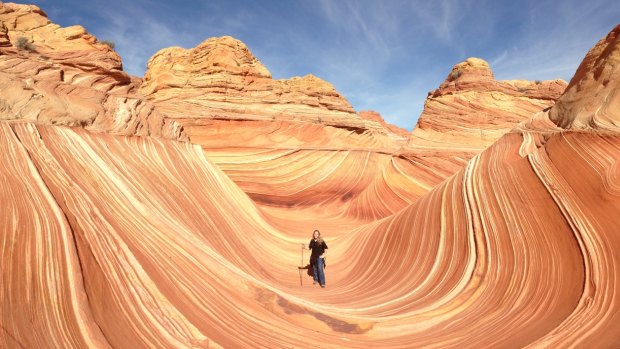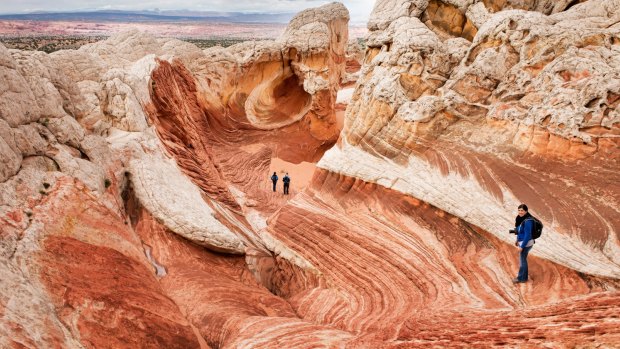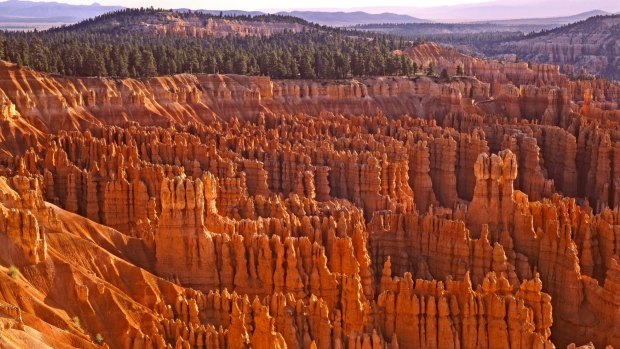This was published 4 years ago
Utah natural wonders: How to see The Wave rock and other highlights
By Anabel Dean

The Wave is an internationally acclaimed wonder of the world secreted in the desert sands of the Paria Canyon-Vermilion Cliffs Wilderness.
The lottery that guarantees 10 permits to visit one of the most psychedelically spectacular rock formations in the United States is about to begin.
A woman thrusts herself to the centre of a jostling crowd. "Am I too late for The Wave Lottery?" she asks, glaring at the national park ranger seated like a benevolent principal behind a white desk. "Applications closed at nine o'clock," responds Steve Behms.
The woman has come from West Virginia and, somewhat implausibly, complains "traffic was bad" in the quiet cow town of Kanab, just north of the Arizona state line in Southern Utah. Behms takes pity. "OK, so, let's take a vote," he counters. "All in favour of this lady scribbling out her application, please raise your hands?"

The remotely rugged White Pocket, 106 kilometres east of Kanab on Paria Plateau, calls for serious wilderness knowhow.
There is silence but for the buzz of insect wings. Not one hand is raised among 78 people.
The Wave is an internationally acclaimed wonder of the world secreted in the desert sands of the Paria Canyon-Vermilion Cliffs Wilderness. The swirling red, pink, yellow and white bands of arching Navajo sandstone may have been created over a few millions of years but they were only discovered by a settler in the 1960s. A visit by a film crew 20 years ago and now, being "Instafamous", has changed everything.
"Good luck to those with numbers corresponding to the balls in the small cage," Behms continues, sending the wheel spinning. "If you win, please don't come up and give me a hug. I appreciate all kinds of positive reactions but just don't touch me. If you don't win, come back tomorrow."

Bryce Canyon is a sprawling reserve with a collection of giant natural amphitheatres where the maze-like layering of millennia has been revealed in spire-shaped rock formations called hoodoos.
The first ball released into the tray belongs to a honeymooning couple who shriek with high-pitched delight and hug everyone in sight. The last ball belongs to a group of three with only two places left. Someone must be "cut" from their party. "Hopefully not for life," Behms jokes.
I am not one of the lucky few to win The Wave Lottery but the sand and cactus country is about to unveil a lesser known miracle. Southern Utah has the highest concentration of natural wonders found anywhere and there are consolation prizes that do not require a permit.
The remotely rugged White Pocket, 106 kilometres east of Kanab on Paria Plateau, calls for serious wilderness knowhow. Behind the wheel of his dust-encrusted jeep, guide Brent Johnson reads the barely marked trail across a desert of biblical proportions with the knowledge of someone born to it. He's a descendent of one of the Mormon pioneer ranchers sent by Brigham Young to settle the community in the spring of 1871 (his surname still adorns Johnson Canyon).
Imagine what it must have been like for the pilgrims who set off in covered wagons with little more than hobnailed boots, a month's supply of bacon and multiple wives into barren gulches that, even today, seem devoid of human beings. We pass only a couple of cars on the three-hour journey across acres of desert but, towards the end, flush a hooded man from scrubby bushes. His ghost disappears into sand hills. "Some people don't want to be found," Johnson shrugs.
White Pocket at first glance appears not so very remarkable: a splodge of chalky cream smeared with a giant palate knife over a parched crust. Soon, though, it reveals astonishing supernatural beauty. Autumnal swirls of stone have been laid and folded and flung like pizza dough, flapped down and hardened, sometimes polished to the palest sheen. Rocks rise sharply, heaved from a molten core, then lurch away in a bewitching display of colour and movement that's cracked and crazed and crinkled, as if only just cooled.
There is nothing remodelled by man here. Time is measured in the lengthening of shadows and the changing direction of the wind. It's as lonely as it is lovely.
Without the crowds, winter is a prize but one that demands as much caution as summer. A higher elevation, walking over rock that absorbs radiant energy, means that it soon gets warmer than anticipated. A day that starts early with frost requires layers of clothing and large quantities of water. "Don't get weird," the ranger warns. "Keep your judgment and your physical ability in tip-top shape because very often, when you hike around here, there is no one to help right away if in trouble."
Our guide leads us into a vast and shallow cave to witness the last signs of human habitation. "It could have been the Navajo, or Paiute, or Apache," he says, pointing to the long-horned sheep etchings scratched deep in rock walls. The sand beneath our feet is flecked with the charcoal shards of fires past but the corn husks and broken pottery have gone. "I don't take many people here," Johnson admits. "Visitors take souvenirs."
A better-known travellers' souvenir lies about three hours' drive away – the epic North Rim of the Grand Canyon which receives only 10 per cent the number of visitors of the South Rim, but is closed in winter. Luckily for us, there's more than one jackpot within easy reach of Kanab, a tidy little town that's a good base for the major sights of Zion and Bryce Canyon national parks.
In the heyday of the western movie, Kanab was a boomtown known as Utah's Little Hollywood, a film location for hundreds of famous movies and television programs (The Lone Ranger, F Troop, Buffalo Bill and others). Photographs of faded Stetson stars line the main street and there's a vague feeling that we might have ridden through town in the remnant Gunsmoke set still visible from the road a few miles out of Kanab.
The best entertainment, however, is along Utah's dramatic Heritage Highway 89 where the geological forces of nature, sculpted by wind and water, have laid bare a 200-million-year-old cross-section of the Earth's history.
Bryce Canyon is a sprawling reserve with a collection of giant natural amphitheatres where the maze-like layering of millennia has been revealed in spire-shaped rock formations called hoodoos. "A hell of a place to lose a cow," declared early settler (and namesake) Ebenezer Bryce. Bill Scoffield, our host at Country Bunkhouse in Cannonville, helps connect us to this deeper history while revealing the full grandeur of Bryce Canyon. His brand of hospitality extends as far as escorting us along 14 inspirational viewpoints best viewed by driving to the end of the road and then wending back to each outlook.
For us, it isn't so much about looking at a view as being amid it, and that means trekking into the velvety upholstery of cliffs that are daubed in shades of umber, tangerine, maroon and aubergine (with an icing of snow dust for good measure). Fear amplifies the senses walking down the icy spine of the Navajo Loop Trail with precipitous and deeply carved ravines on sides that are not always bounded by a railing.
Initially it's a slippery descent, more than 244 metres from Sunset Point through the canyon's Wall Street and Silent City, before making the return climb up the sunny side of the amphitheatre. One of the early explorers described the flame coloured towers as "the banners of God". There is, quite simply, no place on Earth like Bryce Canyon.
There is a rival, though, voted one of the best places to hike in America. Zion National Park, about two hours' drive from Bryce along the extraordinary Zion-Mount Carmel Highway, is many things to many people. We base ourselves in the bustling town of Springdale, right in Zion Canyon, stunned by the sheer stone pinnacles that rise 600 metres into the sky and shrink us to miniature.
An outfitter prepares us for walking knee-deep in water down a narrow slot canyon. Hiking The Narrows means tramping in the Virgin River (in our case for four hours) entombed by the soaring walls of the inner gorge known as the Narrows Canyon. Somehow against the laws of nature in that cold and rushing water, we manage to keep torsos dry wrapped in waders up to armpits, a walking stick countering the feeling that boots are slipping over bowling balls every step up river.
It's an exhilarating experience that can't possibly fit inside a camera: a ponderosa pine clinging improbably to a crevice is about all that fits into the frame.
Some parts of Southern Utah have become so popular that what is loved – a sense of solitude and serenity in a wild place – is at risk of being lost. Management safeguards are now under consideration to cope with mass tourism yet so much red rock country remains largely unknown, or untrammelled, especially in off-peak months when there is still space to breathe.
There are more than a million ways to strike it rich out here without winning the lottery.
TRIP NOTES
Anabel Dean was a guest of Kane County Office of Tourism, St George and Bryce Canyon Tourism.
MORE
STAY
In Kanab, Canyons Boutique Hotel. In Springdale (Zion National Park), Cable Mountain Resort and Spa is a five-minute walk from the entrance to the park and has rooms with fireplaces, kitchens and balconies. See canyonshotel.com; cablemountainlodge.com
EAT
In Kanab, the Rocking V Cafe is a nice bistro filled with travellers tucking into Power Canyon quinoa salad and such like. Or the award-winning sharing-plate sensations of Sego. See rockingvcafe.com; segokanab.com
In Springdale, Switchback Grille serves aged prime steaks and fish is flown in fresh several times a week. See switchbackgrille.com
Sign up for the Traveller Deals newsletter
Get exclusive travel deals delivered straight to your inbox. Sign up now.